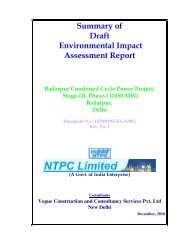proposed integrated complex for delhi judicial academy
proposed integrated complex for delhi judicial academy
proposed integrated complex for delhi judicial academy
You also want an ePaper? Increase the reach of your titles
YUMPU automatically turns print PDFs into web optimized ePapers that Google loves.
Rapid Environmental Impact Assessment (REIA) Study <strong>for</strong> Proposed Integrated Complex <strong>for</strong> Delhi Judicial Academy,<br />
National Law School, and National Institute <strong>for</strong> Mediation & Conciliation at Dwarka, New Delhi<br />
Total Wastewater Quantity from the Residential Complex<br />
= 101 + 31 = 132 m 3 /day<br />
Total Average Wastewater flow from both Academic and Residential Complex is estimated<br />
to be about<br />
= 103 + 132 = 235 m 3 /day<br />
Hence it is <strong>proposed</strong> to set up a Sewage Treatment Plant of capacity 250 m 3 /day.<br />
• AC Make Up Water Requirement:<br />
The make up water requirements <strong>for</strong> the air conditioning plant will be about = 42 m 3 /day<br />
Figure 3.0 gives the water balance diagram of the <strong>proposed</strong> project during the operation phase.<br />
3.4 Building Design Features on Seismic Load<br />
Various measures taken to make the <strong>proposed</strong> building structure earthquake resistance include:<br />
• Building designed as a RCC framed structure.<br />
• The design of frame structures is based on stipulation of I.S. codes of earthquake design (I.S.<br />
1893)<br />
• Ductility provisions to improve earthquake resistivity, as per the Indian Standards<br />
requirement also being incorporated.<br />
As such the structure is designed <strong>for</strong> earthquake resistivity taking into account latest provisions<br />
of Indian Standars codes <strong>for</strong> earthquake resistivity.<br />
3.5 Resource and Construction Material Requirements<br />
Construction of the project components will require the use of renewable and non-renewable<br />
resources including wood, gravel, sand, steel, concrete, cement, bricks and paper products. The<br />
materials, apart from paper products, will be used during the construction period only and will<br />
not be required during the operation phase of the project. Paper products (e.g., paper, cardboard)<br />
will be used during the operation <strong>for</strong> record keeping, general commercial use etc. However, their<br />
use will be minimized. The estimated quantities of construction materials required are given in<br />
Table 3.4.<br />
During the construction activity, it is expected that no fill materials will be transported from<br />
outside. The total quantity of earthwork involved is estimated to be about 91,000 m 3 .<br />
43
















